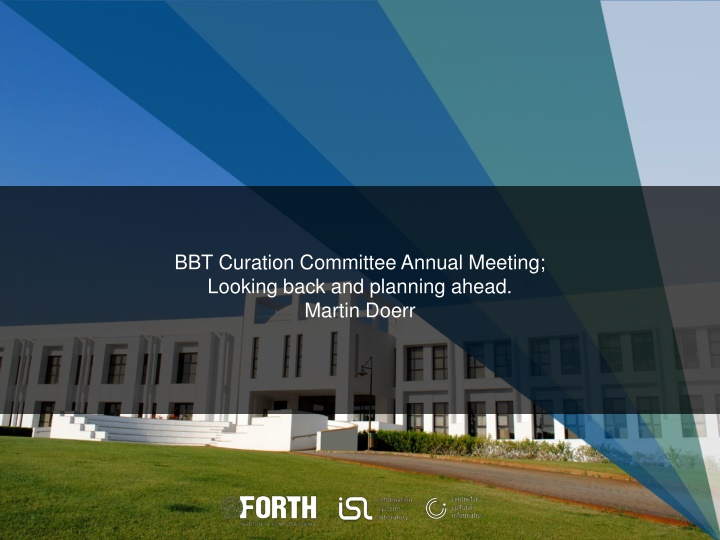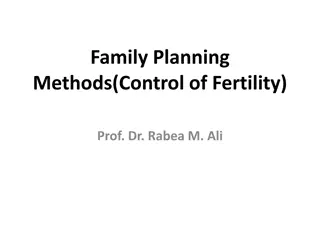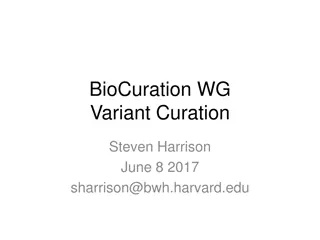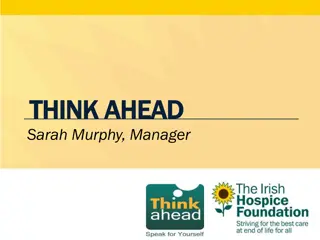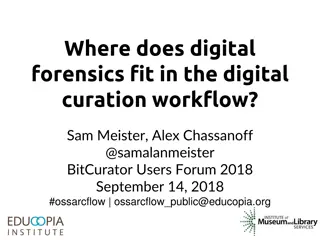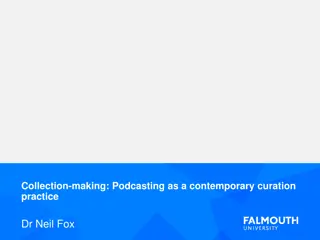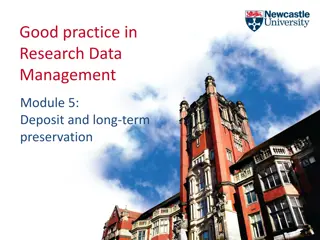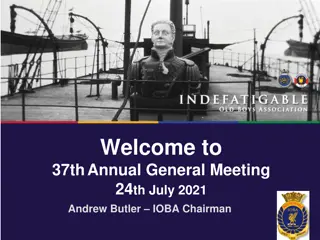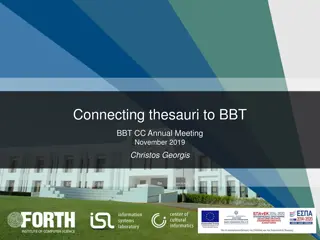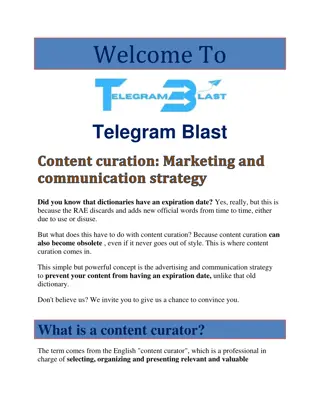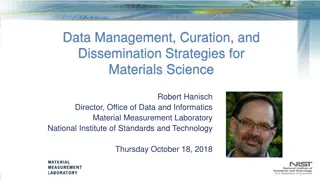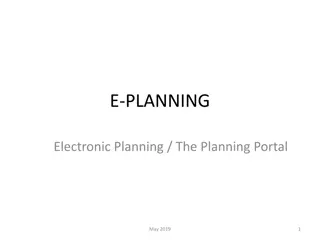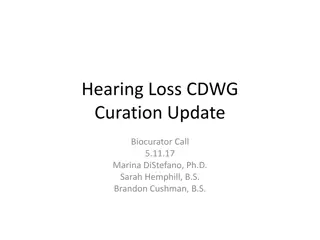BBT Curation Committee Annual Meeting: Looking Back and Planning Ahead
This document covers the proceedings of the BBT Curation Committee Annual Meeting, focusing on reflecting on past activities and outlining strategies for the future. Martin Doerr discusses key points and decisions made during the meeting, shedding light on the committee's direction moving forward.
Download Presentation

Please find below an Image/Link to download the presentation.
The content on the website is provided AS IS for your information and personal use only. It may not be sold, licensed, or shared on other websites without obtaining consent from the author.If you encounter any issues during the download, it is possible that the publisher has removed the file from their server.
You are allowed to download the files provided on this website for personal or commercial use, subject to the condition that they are used lawfully. All files are the property of their respective owners.
The content on the website is provided AS IS for your information and personal use only. It may not be sold, licensed, or shared on other websites without obtaining consent from the author.
E N D
Presentation Transcript
BBT Curation Committee Annual Meeting; Looking back and planning ahead. Martin Doerr
Outline Annual review of the BBT Curation Committee Activities Summary of decisions to be implemented Next steps and prospect collaborations
Annual review of the BBT Curation Committee Activities Provided translations for the BBT facets and hierarchies in French, German and Greek. As a result of this effort, the BBT is now accessible in four languages. Systematically engaged in discussions about the structure of BBT. Participated in the DARIAH Annual Event 2019 in Warsaw and advocated for the use of the BBT, during sessions, posters and the Thesaurus Maintenance WG annual meeting. Advocated for the use of the BBT in the context of the meeting of the Linked Conservation Data Consortium, on the topic of Terminology (June 2019)
Summary of decisions to be implemented Introduce a facet designated for Living Beings (not remains thereof) Introduce a hierarchy within Conceptual Objects (facet) designated for fictional entities Introduce a facet designated for referring to types of geometric places, namely Geometric Extents Add two hierarchies within this facet: points and surface areas Introduce a hierarchy within Conceptual Objects (facet) designated for languages. Rename facet and top term Groups and Collectivities and change its scope note. Change the scope note of BBT term offices Introduce a hierarchy within Social Collective Entities designated for organizations Change the scope note for built environment Change the scope note for physical features
New BBT facet: Living Beings Motivation for new facet: Archaeological excavations dig up skeletons or fossils, which are identified as having belonged to a certain species. The type of creature they belonged to should be identifiable somehow. Iconography, history wrt hunting, collecting, farming: Often terms are different from biodiversity terminology, such as cats No other facet or hierarchy within the BBT can capture that notion. The facet could be called Taxa or Lifeforms or both. A decision should be made during this meeting regarding how to proceed with that: assign work to someone and provide them with a sample to work with
New BBT hierarchy: fictional entities Motivation for hierarchy: Decision made during the Workshop in Heraklion last September, it should make documentation more complete. Fictional entities have unlimited variants and specializations, like universals, but per author, without being a kind. It was decided that this hierarchy will be classifying kinds of Conceptual Objects, however, we might want to reconsider its place in the BBT structure. Maybe they could be captured as kinds of propositional objects instead, in the sense that they are de dicto entities belief statements in essence: I believe that [p], where p = there exists an entity which exhibits properties x,y,z and behaves according to these properties?? To be discussed again in the context of Evelyne s proposal
New BBT Facet: Geometric Extents New BBT hierarchies: points & surface areas Motivation for new facet and hierarchies within: The need to refer to types of geometric places Scope notes for facet, top term and hierarchies points and surface areas accepted; Introduction of hierarchies linear extents and 3D volumes pending. To be reviewed later on, during the meeting
New BBT hierarchy: languages Motivation for new hierarchy: classifying inscriptions or other written works or applications/programs one might need to give information on the means by which they are expressed/rendered. Reference to a language (as a type) need be made. It was decided that this hierarchy be classifying kinds of Conceptual Objects, however, we might want to reconsider its place in the BBT structure. Maybe languages could be captured as kinds of information objects (i.e. specifications of symbolic and propositional objects)?? To be discussed again in the context of Eleni s presentation.
Redefine facet Groups and Collectivities (1/2) i.e. change its name to Social Collective Entities and change its scope note. Motivation for change in name and scope note: Groups and Collectivities seemed to stack together things that were felt to be of different nature, though the difference was not easy to pin down. The old scope note only made reference to relations resulting from the joint actions of people. Despite the fact that groups are defined on the basis of such relations, the relations per se are not identical to the group they define. There has been agreement on the change of the name, but no consensus regarding the proposed changes on the scope note.
Redefine facet Groups and Collectivities (2/2) The preliminary scope note was not accepted for two reasons it conflated properties exhibited atomically by individuals making up the group with properties exhibited collectively (by sums of individuals), which was considered wrong ( fascist ). while trying to resolve that, much emphasis was placed on the notion of self-identification which was also considered unacceptable, because we often tend to group people despite their representation of themselves, in order to study some aspect of their behavior (methodological error!). We should be able to abstract over these aspects/properties and the partitions they create in a given population (epistemology is not terminology). To be discussed again in the context of Eirini and George s presentation
New BBT hierarchy: organizations Motivation for new hierarchy: People tend to make a distinction between well-established groups and spontaneous non-established ones. Avoiding to capture this fact will probably cause problems to end users trying to declare connections to the BBT. Both the introduction of the new hierarchy within Social Collective Entities and the definition provided were accepted: organizations (scope note): This term classifies social units of people structured and managed to meet a need or to pursue collective goals. All organizations have a management structure that determines relationships between the different activities and the members, and subdivides and assigns roles, responsibilities, and authority to carry out different tasks. Organizations are open systems--they affect and are affected by their environment.
Redefine hierarchies built environment and physical features Motivation for changes in the scope notes: Adding a note in their definition suggesting that a reference be made to the geometry of the phenomenal place (where the documentation refers to the spatial extent of the built environment or its location within or on a reference space) follows the decision to include Geometric Extents in the BBT.
Next steps forward and prospect collaborations Map the AAT (at least partially) to the BBT, and see if it results in the need to revise the BBT. The AAT is the oldest thesaurus designated for the Arts and Architecture and there is a large overlap in the domains that both it and the BBT cover. It is also systematically curated, so even though there are mistakes or things that one would rather see made differently/better it always remains a good source for one to consult and to refer to as articulation . Map the Taxonomy of Digital Research Activities in the Humanities (TaDiRAH) to BBT, to make the BBT more visible in the DARIAH community Come up with a strategy of collecting samples of terminologies to continuously validate the proposed classification and engage more institutions to adopt the BBT solution. Linked Conservation Data Ligatus Consortium has shown interest in the BBT as a means to make various terminologies on Art Conservation interoperable. Contact Digital Numismatics WG of DARIAH again, as they had shown interest in aligning with BBT Institutional engagement on BBT should increase, to be demonstrated with aligning to the BBT and becoming part of the thesaurus federation.
